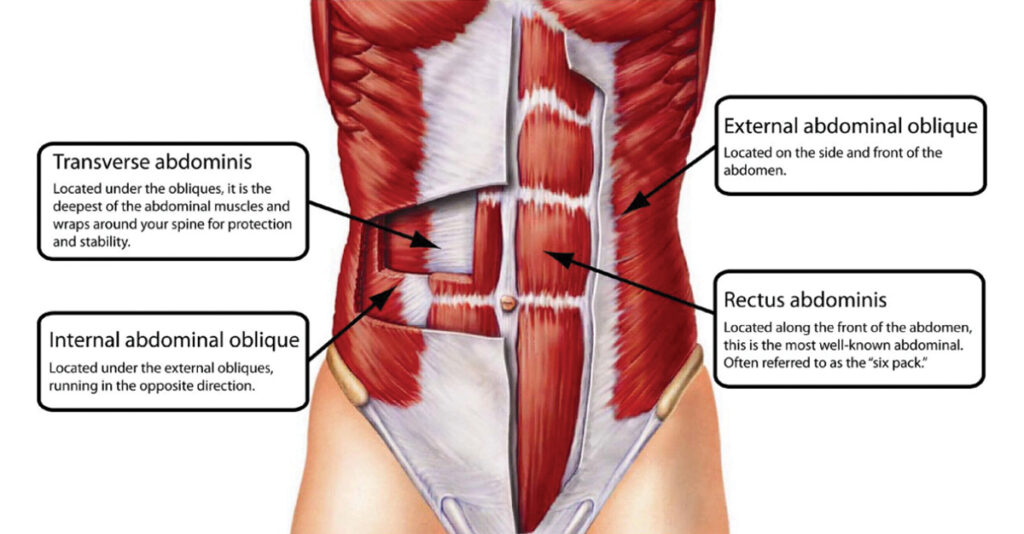 By Lisa Leath Turpin, Health & Fitness Coach/Consultant
By Lisa Leath Turpin, Health & Fitness Coach/Consultant
For the next several months, we will learn from a “Do it Right” series. I dissect the different body parts so you can get a better understanding of the role each muscle plays and ideas on how to tone and strengthen them efficiently and safely to get a more effective workout.
Core, by definition, is “the central, innermost, or most essential part of anything.” Within the body, it’s defined as, “the strength of the underlying muscles of the torso, which help determine posture.” Core exercise is, “any exercise that involves the use of your abdominal and back muscles in coordinated fashion.” Therefore, I figured it appropriate to begin with Abs/Core, because we use our core for just about every movement; it’s our “essential part.” So, we ought to learn how to strengthen it.
 Basically, the muscles that comprise the abdominals are: 1) Rectus Abdominis – the middle “lower abs” and “upper abs,” which curl the pelvis/hips upward or the upper body forward rounding the back in spinal flexion; 2) External Obliques; 3) Internal Obliques – used in twisting the waist or bending sideways; and 4) Transverse Abdominis – runs from front to back and pulls the belly inward. Training your transverse abdominis will help you avoid the “belly pooch” that sometimes happens when working abs incorrectly.
Basically, the muscles that comprise the abdominals are: 1) Rectus Abdominis – the middle “lower abs” and “upper abs,” which curl the pelvis/hips upward or the upper body forward rounding the back in spinal flexion; 2) External Obliques; 3) Internal Obliques – used in twisting the waist or bending sideways; and 4) Transverse Abdominis – runs from front to back and pulls the belly inward. Training your transverse abdominis will help you avoid the “belly pooch” that sometimes happens when working abs incorrectly.
When designing your workouts, it’s most beneficial to choose one or more exercises that hit each one of the ab muscles mentioned. Because abdominal muscles are needed all day for various movements, they are high endurance muscles. They are highly striated which means they have a lot of muscle fibers. Nerves are needed to fire muscle fibers and create movement when the brain says so. But in the abs, there are more muscle fibers than nerves. So, when one set of muscle fibers gets tired, the nerves jump to another set so they can keep the abs performing. Therefore, abs can do more repetitions than other muscles before they get tired… or this should be the case. So, train your abs with endurance as your main objective. Unlike other muscles, they can be trained every day. But, take a break if they get overly sore.
Let’s review the more common ab exercises. Crunch: This movement has received a bad rap lately, but it is a fundamental movement for the rectus abdominis because it performs spinal flexion. Don’t overlook the proper technique. The crunch can be performed on the floor or exercise ball. Lie on your back, knees bent, feet flat on floor, hands behind your head, elbows out, chin tucked toward your chest, lift shoulders off the floor. *You must pull the transverse abdominis in (pull belly button in toward your spine) especially as you crunch. Exhale as you crunch as well. No need to come up very far; simply focus on the spine rounding and look at your lap for proper neck position. PLANKS: Very popular these days. Planks are a static hold. This is a good test for core endurance. Start face down either on elbows or hands, stack shoulders directly above elbows or hands, body in a pushup position, either on toes or knees, but keep body straight. Don’t dip your hips too low. Keep everything stiff like a pencil or 2×4 (plank), and breathe freely. Oblique Twist (i.e. Russian Twist): Done on floor with feet and knees wide, lean back but keep spine rounded, clasp your hands together and move them back and forth from one side to the other smoothly, twisting at your waist, belly button in, breathing freely. Hold a weight for more work and/or hold feet in the air. Now you can apply these fundamental movements to many other abdominal exercises.
Lisa Leath Turpin is a degreed and certified health and fitness lifestyle coach and consultant who has devoted her life to motivating and strengthening the body and mind of others. With over 20 years’ experience, Lisa has a B.S. degree in Sports & Fitness Management from the University of Alabama, developed and managed the U.S. Army Corps of Engineers’ Health & Wellness Facility and programs in Huntsville, Ala., is board certified by the National Board of Fitness Examiners and possesses certifications from AFAA, Polestar/Balanced Body, Reebok U, SCW Fitness and American Heart Association. She is currently a group exercise leader at Destin Health & Fitness and an independent personal trainer in the Destin area, diversely and extensively trained in classical and modern Pilates, lifestyle management, personal training, group exercise and post-rehabilitation. Have a fitness question for Lisa? Email BeActive850@gmail.com.































































